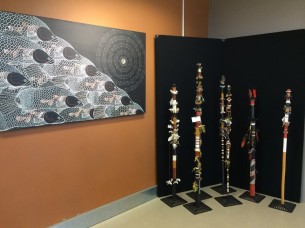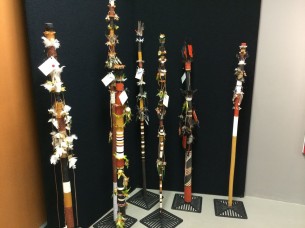We proudly present a collection of special wooden artefacts from Elcho Island adorned with bush string and feathers by John Mangu and Richard Djarrimili.
The Tree of Knowledge is a ceremonial pole that represents the sacred fig tree that grows at Dhudupu near First Creek on Elcho Island. Â It signifies the story of the mokuy spirit that lives beneath the fig tree and eats the figs and kurrajong seeds. Â Traditionally clans would gather at the scacred fig tree for bungul (ceremony). The ceremony awakens and enlivens the spirits, guiding them ‘home’. Â It is a symbolic ceremony of remembrance and of the passing of traditional knowledge to younger generations.


The white feathers at the top of the pole represent the Banumbirr (Morning Star, the star of Venus) which is very bright and tracks across the Arnhem Land sky, setting in the west just before dawn. Â At this time, the light is changing rapidly. Â There is the darkness of the night, punctuated with the reflections of he Morning Star on leaves of the trees, together with the distant glow of the dawn and the fading of the other stars in the sky.
The cord binding the Tree of Knowledge is hand spun from the inner bark layer of the dharrangulk (red flowering kurrajong); Â the feathered rings with the very small feathered pendants are the lomburr; the flowers and fruit of the genydja (fig tree) that grown on the main stems.
Further down the pole the dark feathers depict the dried leaves of dead plants. Â The white and coloured feathers represent the new life given to the plant, which is also representative of new life for the people. Â The bands of different colours of ochre represent the changing light of the early morning, with the black being the night, the yellow and the red being the coming dawn and the white being the rays of sunlight and its reflection on the trees. Â The imagery on the pole also symbolises the artist’s clan and totems.
